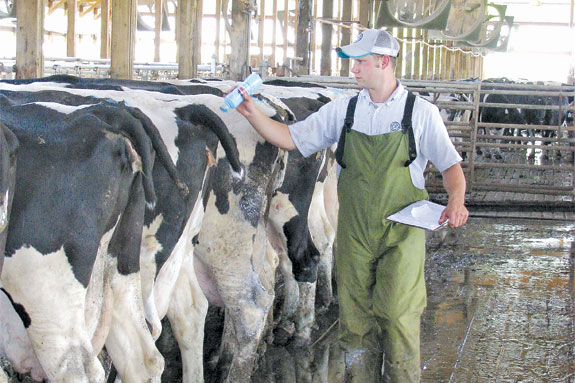The term “preg check” is a misnomer that has been used in the dairy industry for decades. No matter how you determine the reproductive status of cattle following insemination, the goal of the task is to actually find the open cows.
My veterinarian friend, Dr. Scott Poock, has told me, “It was more fun to find pregnancies, but where I made the producer money was in finding open cows.”
The aim of this article is to prove his point and allow producers to evaluate if their current preg check procedure is getting the job done.
The 21-day pregnancy rate is generally used as the benchmark of reproductive success because it is associated with decreases in involuntary culling and days open.
In fact it has been estimated that, depending on the days to conception, the cost of an extra day open can range from $0.81 (80 days to conception) to over $3 per day (140 days to conception). The expected cost of an extra day open increases in herds with less persistency of milk production.
While it’s easy to examine submission rate and conception rate with dairy management software, another important component of the 21-day pregnancy rate formula may be getting overlooked – the number of days between services.
If you don’t know how fast cows are being re-inseminated, then you should check the average heat interval on your dairy management software. The most decisive factor in how to control the interval between services is the frequency and method of pregnancy diagnosis on your farm.

Preg check methods
There are currently five viable methods of pregnancy diagnosis available to dairy producers. The most common methods are estrus detection, palpation per rectum and transrectal ultrasonography. Chances are at least one of these methods is utilized on your farm already.
Estrus detection is a form of pregnancy diagnosis and should be treated as such because a cow that is re-inseminated is deemed open to the previous service. Generally cows will return to estrus between 18 to 25 days after the preceding insemination, so a farm with a 50 percent estrus detection rate can re-inseminate about half of the open cows during this period.
According to research at Texas A&M, rectal palpation is highly accurate when used after day 35 of gestation. This method is typically fast and inexpensive, but caution should be used with inexperienced practitioners because rectal palpation can cause damage to fetal membranes, which may in turn induce pregnancy loss.
Transrectal ultrasonography is the gold standard for pregnancy diagnosis. The ability to visualize the uterine, ovarian and fetal morphology make transrectal ultrasound a unique tool with capabilities no other method mentioned herein can grasp.
Research has shown highly skilled practitioners can begin using transrectal ultrasonography on day 26 and 29 of gestation in dairy heifers and cows, respectively. It should be noted, however, that utilizing transrectal ultrasound at this stage will likely decrease the speed and increase the “questionably pregnant” diagnoses at preg check.
In addition to the more common methods of pregnancy diagnosis mentioned above, cattle can also be diagnosed for pregnancy using laboratory tests for pregnancy-associated glycoproteins (PAG) or progesterone. These tests are pregnancy specific and highly sensitive, which means the risk of false-negatives (misdiagnosing a pregnant cow as an open cow) and false-positives (misdiagnosing an open cow as pregnant) is similar to transrectal ultrasonography.
Furthermore, these tests can be used from day 28 to 30 of gestation through parturition. The progesterone tests are commercially available through multiple vendors, but the sensitivity of this method is generally unsatisfactory because progesterone is not a pregnancy-specific molecule.
With a progesterone test there is almost no risk of a false-negative diagnosis, but greater risk of a false-positive diagnosis compared to rectal palpation, transrectal ultrasound or PAG. The advantage of progesterone-based pregnancy diagnosis is cows identified as open are typically 18 to 24 days past the preceding insemination and can be enrolled for resynchronization at that point.
Make the most of your re-insemination program
There is no right method or best practice for managing repeat inseminations. Each producer must weigh what system best fits their farm. The examples discussed here are aimed at helping producers determine when, how and how often (i.e., weekly, bi-weekly, etc.) they want to preg check cattle.
However, all cattle diagnosed for pregnancy before day 60 of gestation should be re-examined at a later date, as this practice safeguards farms from unidentified pregnancy loss.
The most traditional and simplistic procedure for pregnancy diagnosis is a combination of estrus detection and rectal palpation. This system can be very effective if a respectable estrus detection rate and reasonably fast resynchronization of previously unidentified open cows following palpation are in place.
The use of transrectal ultrasonography or PAG pregnancy diagnosis paired with estrus detection enables producers to be even more aggressive and re-inseminate cattle at ≤35 days after the previous insemination.
Farms that do not employ estrus detection can use transrectal ultrasonography or PAG pregnancy diagnosis at roughly 30 days of gestation, which enables the use of “presynch-resynch” protocols.
For example, researchers at the University of Wisconsin – Madison were able to start a resynchronization protocol 22 days after the previous timed artificial insemination because they used transrectal ultrasonography on day 29, which enabled them to treat open cows with a luteolytic dose of prostaglandin (PGF2α) at preg check.
If interested in using progesterone-based pregnancy diagnosis, there are a couple of caveats to consider. First, a cow diagnosed as open by progesterone will not have a functional corpus luteum, meaning the cow will not respond to prostaglandin at the time of pregnancy diagnosis.
Second, all non-cycling cows will be included in the group of cows identified as open by progesterone pregnancy tests. Therefore, producers using progesterone pregnancy diagnosis will likely benefit from incorporating a presynch-resynch strategy to manage re-insemination in this group of cattle.
Final considerations
Don’t fall into the trap of waiting to preg check until most of the pregnancy loss has occurred. Remember, the goal of a preg check is to find open cows – not to make sure cows are pregnant.
A decrease in re-insemination interval will improve your 21-day pregnancy rate and decrease involuntary culling and lactation length. For farms that have good estrus detection capabilities, the fastest way to re-inseminate cows is to inseminate off detected estrus.
If you are considering making a change to your re-insemination program, make sure to include your veterinarian, extension specialist, employees and/or industry consultants in the decision. PD
References omitted due to space but are available upon request to editor@progressivedairy.com .
Photos courtesy Colten Green.

-
Colten Green
- National Account Specialist
- Genex Cooperative, Inc.
- Email Colten Green





